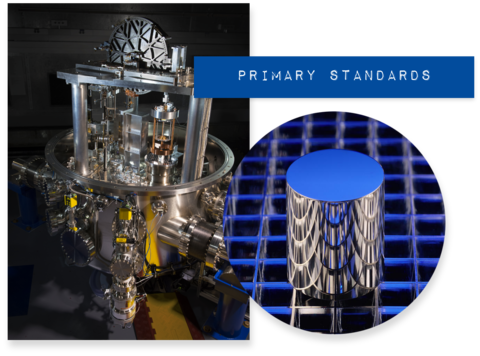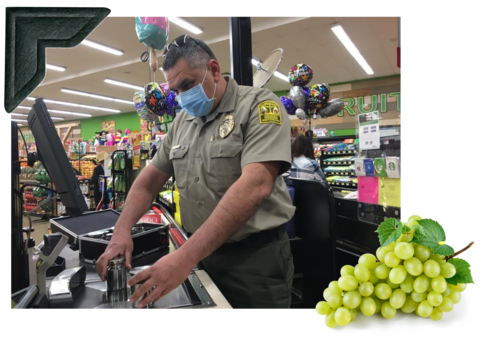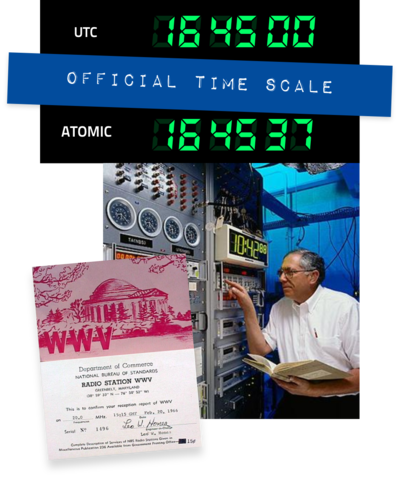Measurement Standards
The other major kinds of standards are measurement standards. While documentary standards are documents, measurement standards are often very tangible physical objects.
Measurement standards help to embody a quantity, such as a second, a kilogram or a meter, and NIST has long played a major role in shepherding them for our nation.

“NIST maintains all the measurement standards for the U.S.,” says NIST’s Jim Fedchak, who heads calibration services at the agency.
Examples of measurement standards include NIST’s F1 and F3 atomic clocks, which serve as the basis for civilian time in the U.S.; and the Kibble balance, which is the basis for all mass measurements.
The standard for the electrical volt is a device known as a Josephson junction, which puts out a highly precise quantity of this electrical unit. The measurement standard for the meter, the unit of length, is actually a beam of light! That’s because the meter is defined as the distance light travels in 1/299,792,458 of a second in empty space, or vacuum.
According to Fedchak, these are known as “primary standards” because they fundamentally define physical units such as the meter and the kilogram without depending on those units. In other words, a light beam doesn’t use a meter stick to define the meter.
But these standards are not very useful sitting in NIST labs. NIST helps to communicate or “disseminate” these U.S. standards to industry, academia and ultimately consumers so they can be confident they have accurate measurements of these units.
NIST helps to create an “unbroken chain” of measurements from the primary standards to the U.S. consumer. And this chain must be traceable: “basically a documented chain of tests and validations, if you will,” Fedchak says, to ensure accuracy is preserved.
“That’s a very hard thing to do,” he adds.

In the case of the kilogram, NIST staff members first weigh a 1-kilogram mass on the Kibble balance, which is in a highly protected “vacuum” environment almost completely devoid of air. Then they compare the mass on the Kibble balance to a second mass. Transported from the Kibble’s vacuum environment to the air, that second kilogram is then weighed on a highly accurate mass scale. That scale is adjusted, or calibrated, as needed to ensure that its reading is consistent with the mass comparison between the second kilogram and the first kilogram in the Kibble balance. Thus begins a chain of measurements that eventually reaches the consumer, Fedchak says.
“That mass scale calibrates another set of masses,” Fedchak says. A state weights and measures inspector might receive one of those sets from NIST. The inspector can then use it to test and calibrate mass scales that are used to test other mass scales in their state. This ensures that the pound of grapes you buy will be accurate and you can trace that measurement of the grapes’ mass all the way back to the national measurement laboratory — NIST.
Another important group of measurement standards revolves around time and its close cousin, frequency. They’re cousins because the second, the basic unit of time, is defined by a frequency, the approximately 9 billion cycles per second (hertz) of electromagnetic radiation released by cesium atoms in standard atomic clocks.
NIST provides the official standards for time and frequency in the United States. To do this, our agency uses the NIST time scale — a system that incorporates data from a group of commercial atomic clocks calibrated by our primary standard, the F1 and F3 clocks. NIST distributes time and frequency data in order to calibrate customers’ equipment down to the nanosecond level.

NIST’s measurement services are primarily remote measurements, made continuously at a customer’s site with a GPS-enabled device, as opposed to one-time calibrations. All measurements are made automatically and are continuously traceable to the International System of Units (SI).
Universities, industry and the military often use NIST’s time services for calibration, synchronization and research. The public primarily uses free services such as the time.gov web clock, the telephone Time of Day service and the WWVB radio broadcast, which sets clocks and watches automatically. The WWV/WWVH shortwave broadcasts are used by everyone from amateur to professional radio operators and for public announcements. The internet time service (ITS) is used to set computer and server clocks. These services are extremely popular — the clocks synchronized by WWVB number in the tens of millions, and the clocks synchronized by ITS perhaps number in the billions.
Recording financial transactions with an accurate time stamp is an essential part of operating a fair and equitable financial market, and NIST has a large role in this endeavor. NIST clock services are used by many stock exchange data centers around the world.
“The Primary Standards Laboratory at Sandia National Laboratories utilizes NIST’s Frequency Measurement and Analysis Service (FMAS) and Time Measurement and Analysis Service (TMAS) to perform time and frequency calibrations,” says Eddie O’Brien, the project lead for Sandia’s Alternating Current Lab. “These systems provide excellent traceability to the International System of Units (SI), with monthly calibration reports delivered by NIST. In addition, the automated nature of the FMAS system simplifies the calibration process. NIST checks on the system daily, ensures it is operating as intended, and quickly resolves any issues.”
So far, we’ve covered fundamental measurement standards centered around the seven base units of the modern metric system, such as the kilogram and second. But there are many more standards, from those that measure the force of airplanes and rocket engines to those that help laboratories accurately measure radiation doses to patients with cancer. There’s even a standard that helps laboratories measure the flatness of objects, important for some high-tech products such as optical mirrors for telescopes. If science or industry has a fundamental measurement need, it’s likely that NIST has a standard for it.

